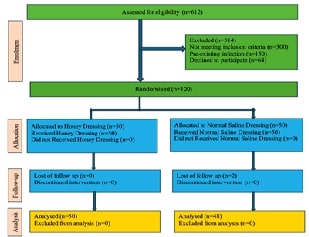Evaluating the Effectiveness of Honey and Standard Dressings on Wound Healing in Open Tibia Fractures: A Randomized Controlled Trial

Abstract:
Wound healing in open fractures presents significant challenges,
especially in low-resource settings, due to high rates of complications. Honey,
known for its antimicrobial and healing properties, offers a potential alternative.
This randomized controlled trial evaluates the effectiveness of honey dressings
compared to standard dressings in wound healing for open tibia fractures. This open-label
randomized comparative trial was conducted at the University Teaching Hospital
of Kigali, Rwanda, involving 100 adult patients with Gustilo IIIA open tibia
fractures of whom 98 patients were analysed. Participants were randomly
assigned to either the intervention group receiving honey dressings or the
control group receiving standard saline dressings. Primary outcomes included
wound healing rate at 30 days, with secondary outcomes assessing wound size,
pain, odour, exudate, and cleanliness. Data analysis was performed using
logistic regression, chi-square tests, and Bayesian methods. The honey dressing
group demonstrated significantly improved outcomes, including faster wound
healing, reduced pain, decreased wound odour, and a greater reduction in wound
surface area by day 30 compared to the control group. Logistic regression revealed
a 10.87-fold increased likelihood of complete healing within 30 days for the
honey group (p< 0.05). The type of dressing used significantly influenced
wound healing, outperforming other factors like bone coverage, previous limb
injury, and residence. Honey dressings significantly enhance wound healing in
open tibia fractures compared to standard dressings, suggesting their potential
as an effective adjunct in fracture management, particularly in
resource-limited settings. Further research is recommended to refine optimal
honey application methods and concentrations.
References:
[1]. Kouassi, K. J., Manon, J., Fonkoue, L.,
Detrembleur, C., & Cornu, O., 2021, Treatment of open tibia fractures in
Sub-Saharan African countries: A systematic review. Acta Orthopaedica
Belgica, 87(1), 85–92. PMID: 34129761.
[2]. Li, J., Wang, Q., Lu, Y., Feng, Q., He, X.,
Li, M. D. Z., et al. 2020, Relationship between time to surgical debridement
and the incidence of infection in patients with open tibial fractures. Orthopaedic
Surgery, 12(2), 524–532.
[3].
Cullen,
S., Flaherty, D., Fitzpatrick, N., Ali, A., Elkhidir, I., & Pillai, A.,
2024, Outcomes following surgical fixation of Gustilo-Anderson IIIb open tibial
fractures. Acta Orthopaedica Belgica, 90(1), 83–89.
[4]. Ahmed, A. S. A. A.,
Eltregy, S., & Kandil, M. I., 2022, Honey dressing: A missed way for orthopaedic wound
care. International Orthopaedics, 46(11), 2483–2491.
[5]. Bernstein, R. C., 2014, The scientific
evidence validating the use of honey as a medicinal agent. The Science
Journal of the Lander, 8(1).
[6]. Molan, P. C., 2006, The antibacterial
activity of honey. Bee World, 73(1), 2–28.
[7]. Blaser, G., Santos, K., Bode, U., Vetter,
H., & Simon, A., 2007, Effect of medical honey on wounds colonised or
infected with MRSA. Journal of Wound Care, 16(8), 325–328.
[8].
Shi,
C., Wang, C., Liu, H., Li, Q., Li, R., Zhang, Y., et al. 2020, Selection of
appropriate wound dressing for various wounds. Frontiers in Bioengineering
and Biotechnology, 8. Frontiers Media S.A.
[9]. Lagoa, T.,
Queiroga, M. C., & Martins, L., 2024, An overview of wound dressing materials. Pharmaceuticals,
17(9), 1110. https://doi.org/10.3390/ph17091110
[10]. Tang, Y., Chen, L., & Ran, X., 2024,
Efficacy and safety of honey dressings in the management of chronic wounds: An
updated systematic review and meta-analysis. *Nutrients, 16*(15), 2455.
https://doi.org/10.3390/nu16152455
[11]. Deviandri, R., Yd, I., & Singh, A.,
2018, Dilution of open fracture grade IIIA of the lower leg using normal saline
0.9% mixed with honey compared with normal saline 0.9% to the bacterial growth.
Orthopedic Research Online Journal, 2(5), 175–178.
[12]. Rajkumar Samdavid Thanapaul, R. J., &
Mannocci, A. S. V. L. T., 2021, An insight into aging, senescence, and their
impacts on wound healing. Advances in Geriatric Medicine and Research,
3.
[13]. Mannocci, A. S. V. L. T., 2019, Male
gender, age, and low income are risk factors for road traffic injuries among
adolescents: An umbrella review of systematic reviews and meta-analyses. Journal
of Public Health, 263–272.
[14]. Mordi, R. M., & Momoh, M. I., 2009,
Incidence of Proteus species in wound infections and their sensitivity pattern
in the University of Benin Teaching Hospital. African Journal of
Biotechnology, 8(5), 725–730. http://www.academicjournals.org/AJB
[15]. Scepankova, H., Combarros-Fuertes, P.,
Fresno, J. M., Tornadijo, M. E., Dias, M. S., Pinto, C. A., et al. 2021, Role
of honey in advanced wound care. Molecules, 26. MDPI AG.
[16]. Hixon, K. R.,
Klein, R. C., Eberlin, C. T., Linder, H. R., Ona, W. J., Gonzalez, H., et al. 2019, A critical review and perspective of
honey in tissue engineering and clinical wound healing. Advances in Wound
Care (New Rochelle), 8(8), 403–415.
[17]. Tashkandi, H. 2021, Honey in wound healing:
An updated review. Open Life Sciences, 16, 1091–1100.
[18]. Albaridi, N. A., 2019, Antibacterial
potency of honey. International Journal of Microbiology, 2019.
https://doi.org/10.1155/2019/2464507
[19]. Nezhad-Mokhtari, P., Javanbakht, S., Asadi,
N., Ghorbani, M., Milani, M., Hanifehpour, Y., et al. 2021, Recent advances in
honey-based hydrogels for wound healing applications: Towards natural
therapeutics. Journal of Drug Delivery Science and Technology, 66.
Editions de Sante.
[20]. Naskar, A., Chatterjee, K., Roy, K., Majie,
A., Nair, A. B., Shinu, P., et al. 2024, Mechanistic roles of different
varieties of honey on wound healing: Recent update. Journal of Pharmacology
and Pharmacotherapeutics, 15, 5–18.
[21]. Vandamme, L., Heyneman, A., Hoeksema, H.,
Verbelen, J., & Monstrey, S., 2013, Honey in modern wound care: A
systematic review. Burns, 39, 1514–1525.
[22]. Clark, M., & Adcock, L., 2018, Honey
for wound management: A review of clinical effectiveness and guidelines. CADTH
Rapid Response Report: Summary with Critical Appraisal.

